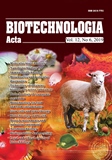ISSN 2410-776X (Online)
ISSN 2410-7751 (Print)

"Biotechnologia Acta" V. 12, No 6, 2019
Р. 65-70, Bibliography 14, English
Universal Decimal Classification: 631.46.631.445.41:631.84
https://doi.org/10.15407/biotech12.06.065
Institute of Agriculture of the National Academy of Sciences of Ukraine, Kyiv
The aim of the work was to study the direction and intensity of mineralization and immobilization processes in different layers of gray forest soil at fallow fields, extensively and intensively used agrosoils. The research included laboratory analysis, microbiological studies, and statistical processing. For the fallow plots, the layers chosen for study were Hd – turf (0–10 cm), He – humus-eluvial (11–40 cm), Hi – humus-illuvial (41–74 cm), Ih – illuvial-humus (75–115 cm), Ip – transitional from the illuvial layer to bedrock (116–156 cm), Pi – bedrock with occasional insertions of illuvial soil (157?191 cm); for the agrosoils of the stationary experiments: He – humus-eluvial (0-10 and 11–40 cm), Hi – humus-illuvial (41–74 cm), Ih – illuvial-humus (75–115 cm), Ip – transitional from the illuvial layer to bedrock (116–56 cm). We found that humus mineralization differed in some layers of the gray forest soil under these management regimes. At fallows, the intensity of humus mineralization tended to decrease with depth, and it was interrupted in the Ih and Ip layers. In the intensively used agrosoil, humus mineralization was more active in Hi- and Ih- layers. Comparatively, the activity of humus mineralization smoothly decreased in the profile of the extensively used agrosoil from the uppermost layer to the lower by 97.2%. The mineralization coefficient of Nitrogen compounds gradually decreased in the fallow ground and extensively used agrosoil, unlike the intensively managed agrosoil, in which the intensity of mineralization-immobilization of nitrogen compounds increased in the He and Hi layers. It was shown that the fallow ground had the more efficient system to transfer substrates and mineral ions down the profile to the lower layers. The difference in biologic activity between the upper and lower layers was maximum in the fallow ground, intermediate in the intensively used agrosoil and minimum in the extensive agrosoil.
Key words: soil horizons, index of pedotrophy, nitrogen mineralization coefficient, humus mineralization activity, fallow ground, agrosoil
© Palladin Institute of Biochemistry of National Academy of Sciences of Ukraine, 2019
References
1. Polianskaya L. M., Heidebrecht V. V., Stepanov A. L., Zvyagintsev D. G. The distribution of the number and biomass of microorganisms according to the profiles of zonal soil types. Pochvovedeniye. 1995, No 3, 322–328. (In Russian).
2. Golovchenko A. V., Polyanskaya L. M., Dobrovolskaya T. G. Features of the spatial distribution and structure of microbial complexes of swamp-forest ecosystems. Pochvovedeniye. 1993, 10, 77–90. (In Russian).
3. Golovchenko A. V., Dobrovolskaya T. G., Chernov I. Yu. The structure of bacterial complexes in protected spruce forests. Pochvovedeniye. 1995, 9, 1121–1124. (In Russian).
4. Dobrovolskaya T. G., Chernov I. Yu., Lukin S. M. Bacterial diversity of virgin and arable I. I.u. soils of the Vladimir region. Pochvovedeniye. 2001, 9, 1092–1096. (In Russian).
5. Mishustin E. N., Runov E. V. Successes in developing the principles of microbiological diagnosis of soil conditions. Uspekhi sovremennoy biotekhnolohii. Moskva, AN SSSR. 1957, 44, 256–267. (In Russian).
6. Nikitin D. I., Nikitina V. S.. Self-cleaning processes and parasites. Moskva: Nauka. 1978, 205 p. (In Russian).
7. Demkina T. S., Zolotareva B. N. Microbiological processes in soils at various levels of intensification of agriculture. Vilnus. 1986, 103, 101. (In Russian).
8. Kariahina L. A. Microbiological fundamentals of increasing soil fertility. Mn.: Science and technology. Minsk: Nauka i tekhnika. 1983, 181 р. (In Russian).
9. Rusakova, I. V. Biological properties of sodpodzolic sandy loam soil with prolonged use of straw for fertilizer. Pochvovedeniye. 2013, 1493 (12), 1485. (In Russian).
10. Gamalay B. I., Korsun S. G. Particular processes of land settlement on land for processing lands. Zbіrnyk nauk. prats Instytutu zemlerobstva. Kyiv: Norra Print. 2003. 25 (4), 25. (In Ukrainian).
11. Malinovska I. M., Tkachenko M. A. The number and physical activity of microorganisms of the genetic horizons of the gray fox area for different purpose. Zbirnyk naukovykh prats Instytutu zemlerobstva. 2015, 4, 13–24. (In Ukrainian).
12. Malinovska I. M., Soroka O. P. Rebooting microbial processes at fallow lands and agrozems. Hruntosnavstvo. 2011, 12 (3–4), 84–91. (In Ukrainian).
13. Gorodetska S. P. Diya Dobriv і crops on the balance of humus in the grain-saponny sіvozmіnі. Zbirnyk naukovykh prats Instytutu zemlerobstva, UAAN, Kyiv. 2003, Issue 1–2, 55–64 р. (In Ukrainian).
14. Polyanskaya L. M., Zvyagintsev D. G. Microbialsuccessioninsoil. Soviet scientist reviews. Horwood Academic Publ. Gmbh. 1994, 1, 1–65.

